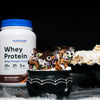Vitamin D3 and Your Kids│What You Need to Know

Of course, you as a parent want your kids to grow up happy and healthy. Kids need strong bones and healthy bodies to keep up with their playful lifestyle so it’s important to incorporate the proper daily amount of vitamin D3.
First, let's talk a little more about what vitamin D3 is and why it’s important.
Vitamin D3 is a vitamin found naturally in foods like salmon, herring, sardines, egg yolks, mushrooms, cow’s milk, and soy milk. It supports the body’s ability to absorb calcium, which is another important nutrient that helps support and strengthen strong bones.
It also plays an important role in preventing heart disease, diabetes, osteoporosis, and thinning bones. Vitamin D3 deficiencies, such as rickets, can be avoided when vitamin D3 and calcium are incorporated appropriately into one’s diet.
How Do We Get Vitamin D3?
We love a good day out in the sun! One great thing about vitamin D3 is it can be produced in the body when our skin is exposed to the sun by soaking up the sun's rays. It can also be found in our diets like in the foods listed above.
Most kids can get enough vitamin D3 from time spent outside, especially between April and October. Just 15-30 minutes outside with hands and face exposed may help the body to produce enough of the vitamin D3 a child needs.

What Are the Benefits of Vitamin D3?
This "Sunshine Vitamin" is considered essential for kids and may aid in building strong bones and boosting their immune system.
Some long-term benefits of vitamin D3 intake include:
- Maintain strong healthy bones and teeth
- Support nervous system health
- Strengthen defenses against infections
- Improve lung and heart health
How Much Vitamin D3 Should My Kids Be Taking?
Kids 1 year old and younger: 400 IU (international units) of vitamin D3 daily
Kids older than 1 year: between 600 to 1,000 IU of vitamin D3 daily
For older kids, a common source of vitamin D3 is milk. 1 quart or 32 oz of milk has about 400 - 460 IU of vitamin D3. If children aren’t drinking enough milk or receiving vitamin D3 from other foods, they may need a daily supplement with 600 IU of vitamin D3.
Who Needs Additional Vitamin D3?
Kids with more melanin in their skin, who don’t venture outside, or who wear clothing that covers most of their skin regularly, may need supplementation. Regarding sunscreen, it’s important to protect children from sunburns and other exposures to the sun, but depending on the SPF that you are using, vitamin D3 can be reduced by over 95%.
It’s important to note that medications interfere with vitamin D3, so make sure your child’s pediatrician is aware of all medications they take before suggesting any supplements.
How Much Vitamin D3 is Too Much?
There is a toxicity level for vitamin D3 intake. Too much vitamin D3 for kids from supplements can be harmful. It can increase the chances of developing hypercalcemia (which can cause nausea, vomiting, weakness, and frequent urination). Too much vitamin D3 may also lead to bone pain and kidney problems.
If you’re worried about your child’s vitamin D3 intake please be sure to contact your pediatrician.
What Can Affect How Much the Body Absorbs Vitamin D3?
Location
During the few months of the year where sunlight is sparse, vitamins may be a smart solution to fulfill kids’ vitamin D3 needs. Living in a city or region with limited sunlight exposure can significantly reduce one’s ability to naturally absorb and produce vitamin D3. For example, places such as New England or the Pacific Northwest may not get enough sunlight, affecting its residents.
Breastfeeding Babies
Breastmilk doesn’t always provide enough vitamin D3 naturally. A solution to this regarding supplementation includes drops of vitamin D3 given to babies (400 IU daily) or the mother can take vitamin D3 supplementation with 5,000 IU a day. There are ways to determine whether one’s baby is receiving enough vitamin D. Doctors can provide a simple blood test to better determine how much vitamin D3 is present in the body. It’s always a good idea to meet with a health care provider with any questions or concerns regarding vitamin supplementation.
Conclusion
Vitamin D3 is a fairly easy vitamin for kids to get on their own through regularly staying active outdoors. Luckily, there are a variety of options in case children aren’t able to get a healthy amount of vitamin D3 through just diet and sun exposure.
Vitamin D3 supplementation may support the fulfillment of a healthy vitamin D3 intake if necessary. As always, it’s recommended that parents meet with their child’s health care provider before adding any supplementation to their child’s diet.
*These statements have not been evaluated by the Food and Drug Administration. This product is not intended to diagnose, treat, cure, or prevent any disease.
Sources
https://www.chop.edu/news/health-tip/vitamin-d-supplements-what-parents-should-knowhttps://kidshealth.org/en/parents/vitamin-d.html
https://www.healthychildren.org/English/healthy-living/nutrition/Pages/Vitamin-D-On-the-Double.aspx
https://www.webmd.com/children/news/20080528/kids-may-need-10-times-more-vitamin-d
https://www.webmd.com/drugs/2/drug-152054/kids-vitamin-d3-oral/details
https://www.cdc.gov/nutrition/infantandtoddlernutrition/vitamins-minerals/vitamin-d.html
https://www.webmd.com/diet/guide/vitamin-d-deficiency#1
-
Posted in
Bone Health, Immune Support, Kids, Vitamins










